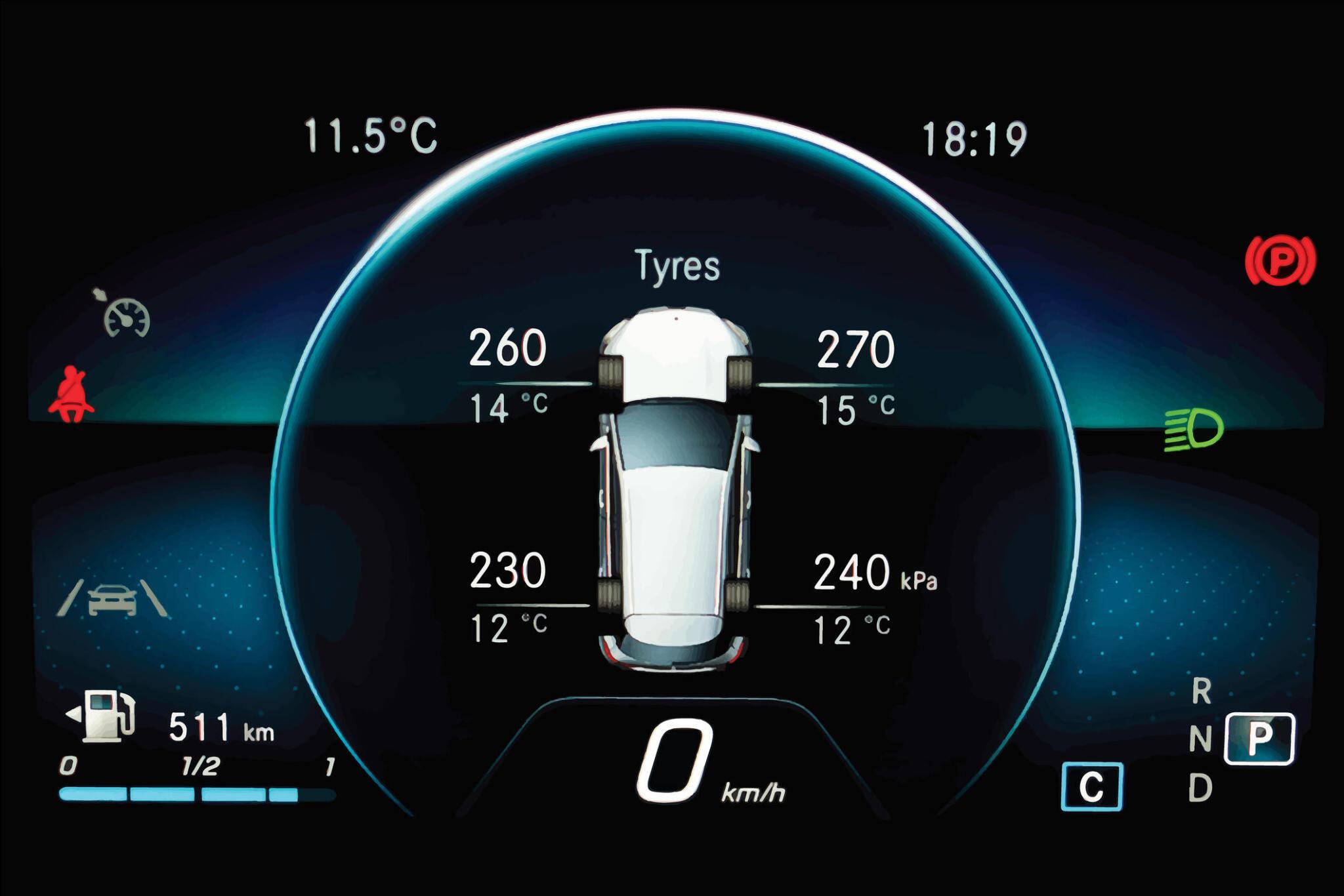Last Updated on April 21, 2024
TPMS Sensors and Market Trends
The growth of vehicle technology has always aimed to improve safety, efficiency, and user experience. One of the most critical advancements in this area is the Tire Pressure Monitoring System (TPMS). This article looks into the fundamentals of TPMS, its value to drivers, and the most recent trends and advancements influencing this technology.
What is TPMS?
TPMS stands for Tire Pressure Monitoring System, an advanced system designed to monitor the air pressure inside the pneumatic tires of various types of vehicles. This system offers real-time information to the driver, typically through a gauge, a pictogram display, or a simple low-pressure warning light.
How Does TPMS Work?
The two primary types of TPMS are indirect and direct. Direct TPMS detects tire pressure directly using pressure monitoring sensors within each tire and delivers the information to the car’s computer system. In contrast, indirect tire pressure monitoring systems (TPMS) employ the car’s anti-lock braking system (ABS) sensors to detect air pressure by monitoring how quickly the tires rotate.
Importance for Drivers
Proper tire inflation is crucial for drivers because it improves safety by preventing loss of control and tire failure, ensures cost effectiveness through optimal fuel consumption, extends tire life by encouraging even wear, and benefits the environment by decreasing CO2 emissions.
- Safety: For safe driving, proper tire inflation is essential. Reduced control, extended stopping distances, and, in extreme situations, tire failure can result from underinflated tires.
- Cost-Effectiveness: Properly inflated tires provide the best fuel economy. Underinflated tires have more rolling resistance, which means the car uses more gasoline.
- Tire Longevity: By ensuring that tires wear uniformly, regular tire pressure monitoring helps tires last longer.
- Environmental Benefits: Properly inflated tires help lower CO2 emissions by maximizing fuel efficiency.

Recent Trends and Innovations in TPMS Technology
The combination of TPMS and intelligent technologies is a significant development. An innovative tire pressure monitoring system (TPMS) that can wirelessly communicate data to mobile phones or automobile infotainment systems provides drivers real-time updates and detailed tire performance analytics.
Integration with Vehicle Safety Systems
Modern TPMS is increasingly integrated with other vehicle safety systems, like electronic stability control (ESC) and ABS, to enhance overall vehicle safety. This integration allows for more sophisticated responses to tire pressure issues.
Solar-Powered Sensors
Manufacturers are offering solar-powered solutions to address the issue of TPMS sensors’ short battery life. By absorbing solar energy, these sensors reduce the need for frequent battery replacements, increasing the system’s sustainability.
Predictive Analytics
Predictive analytics technologies are currently available for refined TPMS. These devices can evaluate previous tire pressure data to predict future challenges and warn drivers of issues before they occur.
Market Expansion and Regulation
Strong safety rules in Europe and North America drive the worldwide TPMS industry. The legal necessity for TPMS in new vehicles contributes significantly to this increase.
Customizable Alerts and Interfaces
Modern TPMS includes user-friendly alerts and interfaces, allowing drivers to set pressure limits and choose how they get information. This personalization improves the user experience and ensures that drivers receive information that is personalized to their preferences.
TPMS technology has become an essential part of modern car safety systems. Its evolution from a critical safety component to a complex, integrated system demonstrates the automotive industry’s commitment to enhancing driver safety and vehicle efficiency. We expect TPMS to become even more innovative as technology advances, offering drivers more significant insights and control worldwide.
Balancing Cost and Quality: What You Need to Know
Tire Pressure Monitoring Systems (TPMS) are pivotal in automotive safety. However, with a diverse range of TPMS sensors available in the market, it becomes crucial for consumers to balance cost with quality. This article segment sheds light on navigating the price spectrum of TPMS sensors and identifying key quality indicators.
Assessing the Price Spectrum of TPMS Sensors
The market for TPMS sensors is significant, and prices vary widely. Factors influencing the cost include technology (direct vs. indirect), brand recognition, additional features, and compatibility with specific car types.
Entry-Level Sensors
Entry-level TPMS sensors are the cheapest because they use simpler technology and have limited features. These are perfect for clients who prefer essential tire pressure monitoring with no additional features.
Mid-Range Sensors
Mid-range TPMS sensors achieve a balance between price and advanced functionality. They include improved durability, accuracy, and compatibility with a broader range of vehicles.
High-End Sensors
The high-end area includes TPMS sensors that combine cutting-edge technology, such as intelligent networking, improved testing, and longer battery life. These suit customers who require complete tire monitoring and are willing to pay more for advanced features.
Considering the Total Cost of Ownership
When assessing the price, consider the total cost of ownership, which includes installation, maintenance, and possible battery replacements.
Key Quality Indicators for TPMS Sensors
Understanding the quality of Tire Pressure Monitoring System (TPMS) sensors is essential for vehicle safety and performance. In this post, we will look at the key aspects that determine the dependability and effectiveness of TPMS sensors, allowing you to make more educated decisions about your vehicle’s maintenance.
Accuracy and Reliability
A high-quality TPMS sensor should provide you with correct and continuous readings. Reliable performance under various temperature and pressure conditions is essential for safety.
Battery Life and Power Consumption
The lifespan of the sensor’s battery is an essential feature. Sensors with longer battery life offer more convenience and cheaper maintenance costs.
Durability and Build Quality
High-quality TPMS sensors are built to withstand harsh conditions like chemical exposure, severe temperatures, and physical impact.
Compatibility and Ease of Installation
The best TPMS sensors are easily adaptable to various vehicle models and types. Ease of installation is also essential because complex installation processes might raise costs.
Advanced Features
A high-quality sensor may have additional features like Bluetooth connectivity, smartphone integration, and real-time notifications. However, it is critical to determine whether these capabilities are worth the extra expense.
Warranty and Customer Support
A strong warranty and accessible customer support are indicators of a manufacturer’s confidence in their product and commitment to customer satisfaction.
When balancing cost and quality in TPMS sensors, it is essential to understand that while higher prices are always associated with higher quality and advanced capabilities, the most expensive option is not always the best choice for some customers. Assessing individual needs, considering the total cost of ownership, and recognizing key quality indicators can assist consumers in making an informed purchase that ensures safety while staying within their budget.
Top Value TPMS Sensors: A Comparative Review
Choosing the right Tire Pressure Monitoring System (TPMS) is essential in your search for vehicle safety. The comparison study will look at several TPMS sensors, from entry-level to premium, allowing consumers to make informed decisions depending on their requirements and budget.
Entry-Level TPMS Sensors: Pros and Cons
Entry-level TPMS sensors provide a simple solution for vehicle safety, but they have pros and disadvantages. In this post, we’ll look at the benefits and drawbacks of these low-cost sensors, assisting you in determining whether they’re the best option for your vehicle’s needs and conditions.
Pros of Entry-Level TPMS Sensors
- Affordability: The primary advantage of entry-level sensors is their low cost. They are a good option for budget-conscious shoppers.
- Basic Functionality: These sensors provide the essential feature of monitoring tire pressure, which is sufficient for most driving scenarios.
- Ease of Installation: Many entry-level TPMS sensors are intended for simple usage and installation, making them an excellent choice.
Cons of Entry-Level TPMS Sensors
- Limited Features: They often need more advanced features like intelligent connectivity or detailed diagnostics.
- Variable Accuracy: Some entry-level models may offer a different level of correctness and continuity than higher-end models.
- Lesser Durability: The build quality and materials might be less robust, affecting their long life and performance in extreme conditions.
Mid-Range TPMS Sensors: Balancing Features and Price
Mid-range TPMS sensors offer a balance of advanced capability and pricing, making them an affordable option for many automobile owners. This article examines how these sensors balance use and cost, providing information to help you decide whether they fit your vehicle’s needs best.
Advantages of Mid-Range TPMS Sensors
- Improved Accuracy and Reliability: Mid-range sensors are frequently more accurate and reliable than entry-level sensors. Temperature monitoring, faster notifications, balancing functionality, and pricing are among the additional capabilities that these sensors may provide.
- Improved Durability: Mid-range sensors with superior build quality may withstand more challenging conditions and last longer.
Considerations for Mid-Range TPMS Sensors
- Moderate Pricing: While less expensive than premium alternatives, mid-range sensors are more costly than entry-level choices.
- Various Compatibility: Some models in this range may require specific vehicle compatibility, so check the fit carefully.
Premium TPMS Sensors: Are They Worth the Investment?
Premium TPMS sensors are at the top of the industry, offering more features and better performance. This article delves into the value proposition of these high-quality sensors, establishing whether the higher investment will benefit your vehicle.
Pros of Premium TPMS Sensors
- Advanced Technology: Premium sensors usually include cutting-edge technology, such as real-time data transmission to smartphones or integration with car systems.
- Highest Accuracy and Reliability: These sensors provide highly accurate and consistent readings.
- Long Battery Life and Robust Construction: They are reliable because they have long-lasting batteries and quality construction components.
Cons of Premium TPMS Sensors
- High Cost: The main disadvantage is that costs may be much higher than in other categories.
- Complexity: Advanced features may add complexity, needing professional installation or a specific level of knowledge for maximum performance.
Assessing the Value
Premium TPMS sensors are often known for their long lifespan, unique functionality, and added peace of mind. They are usually an excellent purchase for consumers who value advanced automotive safety features, drive luxury or high-performance vehicles, or appreciate the ease of cutting-edge technology.

Essential Features vs. Luxury Add-ons
When it comes to Tire Pressure Monitoring Systems (TPMS), knowing the difference between basic features and luxury add-ons is necessary for making the most cost-effective and practical choice. We will look at the must-have features of a TPMS sensor and if they are a luxury or a necessity.
Must-Have Features in a TPMS Sensor
A must-have TPMS sensor should provide real-time pressure monitoring for safety and performance, accurate and consistent readings to avoid false alarms, durability and weather resistance for dependability, a long battery life to reduce maintenance, ease of installation and universal compatibility, and clear warning signals for low and critically low tire pressure to ensure timely alerts to the driver.
Real-Time Pressure Monitoring
The core function of any TPMS sensor is to provide real-time tire pressure information. This feature is non-negotiable as it directly impacts vehicle safety and performance.
Accuracy and Consistency
A TPMS sensor must produce accurate and reliable readings. Inaccurate data can cause false alarms or no warning at a critical time.
Durability and Weather Resistance
TPMS sensors are exposed to harsh settings such as severe temperatures and road toxins. As a result, durability and weather resistance are essential for dependable operation.
Battery Life
Long battery life is essential for reducing maintenance. A TPMS sensor should last for several years before requiring a battery replacement.
Ease of Installation and Compatibility
The sensor should be simple to install and suitable for various cars. This functionality is vital for those who may want expert installation services.
Warning Signals
The system should provide obvious and identifiable warning signals for low and dangerously low tire pressure, ensuring that the driver is immediately informed of future problems.
Additional Features: Luxury or Necessity?
The line between luxury and need in product features can sometimes be unclear. This article dives into various additional product features, looking at their use and impact to help you decide if they are luxuries or essential additions to your needs.
Advanced Diagnostics
Some high-end TPMS sensors provide advanced testing, such as predicting tire wear and detecting slow leaks. While helpful, these characteristics are not required for a TPMS’s core function.
Solar Charging
Some high-end TPMS sensors provide advanced testing, such as predicting tire wear and detecting slow leaks. While helpful, these characteristics are not required for a TPMS’s core function.
Customizable Alerts and Interfaces
The ability to customize alerts and the user interface is a luxury feature that improves the user experience but is not essential for a TPMS sensor’s functionality.
Temperature Monitoring
While pressure monitoring is required, temperature monitoring is an optional feature. It can provide helpful information, especially in bad weather, but it is unnecessary for a TPMS.
User Experiences and Ratings: Real-World Insights
Understanding customer feedback and ratings is essential when buying a Tire Pressure Monitoring System (TPMS). They provide practical information that can inform and guide potential buyers. This part analyzes consumer happiness through customer evaluations and ratings and then digs into case studies to show how different TPMS sensors work in real-life situations.
Analyzing Online Reviews
Online reviews and ratings have plenty of information. They offer firsthand accounts of product performance, durability, and ease of use.
Importance of Balanced Reviews
While positive feedback is encouraging, balanced feedback may give a more accurate view. They frequently stress the product’s strengths and drawbacks, providing potential customers with in-depth knowledge.
Assessing the Reliability of Reviews
It is essential to determine how accurate the reviews are. Are they from verified buyers? Are they providing real accounts or just wrong statements? Reliable reviews usually provide particular information about the user’s experience with the product.
Understanding Ratings
Ratings are often given as stars or numerical scores, providing a quick overview of overall satisfaction. However, they should be used with written reviews to understand the reason for the scores.
Case Studies: How Different TPMS Sensors Perform in Real Scenarios
This article examines real-world applications and performance, including case studies of how various TPMS (Tire Pressure Monitoring System) sensors work in different situations. It thoroughly analyzes their functionality and dependability, providing valuable insights into their performance in regular cases.
Case Study Methodology
Case studies contain detailed evaluations of TPMS sensor performance in everyday situations. This can cover various vehicles, driving conditions, and user behaviors.
Example 1: Daily Commuting
The TPMS market is growing internationally due to North American and European safety standards. This rise is primarily due to the regulatory requirement for TPMS in new cars.
Example 2: Long-Distance Travel
Long-distance travel tests are conducted on TPMS sensor durability and battery life. In this case, studies can demonstrate how sensors function over a long period and in varying weather conditions.
Example 3: Off-Road Use
Off-road driving presents specific difficulties for TPMS sensors, including navigating uneven terrain and significant changes in tire pressure. User experiences under similar conditions can demonstrate the resilience and robustness of various sensors.
Learning from Real-World Experiences
Real-world experiences and case studies provide practical insights that laboratory tests and specification sheets cannot. They reveal how TPMS sensors cope with the complexities and unpredictabilities of everyday use.
Installation and Maintenance: Hidden Costs Unveiled
Considering the installation and maintenance costs of a Tire Pressure Monitoring System (TPMS) and the initial costs is essential. These variables may significantly impact the system’s usability and overall cost of ownership. This article looks at the installation procedure, contrasting do-it-yourself and expert setups. It also looks at the longevity and maintenance needs of TPMS, offering insights into the expenses accumulated over time.
Professional Installation
- Expertise: Professional installation is recommended for internal TPMS sensors. Technicians have the necessary knowledge and tools to ensure proper installation.
- Calibration and Testing: Professionals can also calibrate the sensors and perform necessary tests to ensure the system functions correctly.
- Cost Implications: While more costly upfront, professional installation can provide peace of mind and prevent costly mistakes in a DIY setup.
Maintenance and Longevity: Cost Over Time
Over time, the cost-effectiveness of investments can be significantly affected by how well you maintain and extend their life. This article will help you understand and manage the long-term financial costs of your purchases by looking at maintenance plans and ways to extend the life of products.
Sensor Battery Life
- Replacement Costs: Battery replacement is one of the primary maintenance costs for TPMS sensors. While some sensors have replaceable batteries, others require complete sensor replacement once the battery dies.
- Battery Longevity: The battery’s long life depends on the sensor’s type and quality. On average, TPMS sensor batteries can last 5 to 10 years.
Sensor Damage and Wear
- Regular Checks: TPMS sensors can be damaged by road dirt, chemicals, and general wear and tear. Regular checks are essential for ensuring their functionality.
- Replacement and Repair Costs: Depending on the extent of damage, sensors might need repair or replacement, which means additional costs.
System Updates and Calibration
- Necessity of Recalibration: TPMS systems may require recalibration or reprogramming, especially after tire changes, rotations, or sensor replacements.
- Cost of Calibration: Some systems can be recalibrated at home, while others may require a professional service, increasing maintenance costs.
Long-Term Value
Understanding the long-term worth of TPMS sensors requires considering their longevity and maintenance needs. Over time, a more costly sensor with excellent durability and longer battery life can be a better investment than a less expensive but less reliable one.
Making the Right Choice: Tips for Buyers
Selecting the right Tire Pressure Monitoring System (TPMS) sensor for your vehicle can be daunting, given the variety of options available. This guide aims to simplify the decision-making process, providing a checklist for choosing the best value TPMS sensor and insights into future-proofing your purchase.
Compatibility with Your Vehicle
- Ensure that the TPMS sensor is compatible with your vehicle model and make. Compatibility is crucial for the sensor to function correctly.
Type of TPMS Sensor
- Decide between direct and indirect TPMS sensors based on your vehicle’s requirements and the specific features you need.
Accuracy and Reliability
- Look for sensors known for their accuracy and reliability. Check user reviews and ratings for insights into these aspects.
Battery Life and Replacement
- Consider the sensor’s battery life. A longer battery life means fewer frequent replacements and lower maintenance costs.
Ease of Installation
- Check whether the sensor can be installed easily or if it requires professional assistance. This can affect your initial setup cost.
Features Offered
- Determine what features are important to you. Basic models offer simple pressure monitoring, while advanced models may include temperature readings, real-time alerts, and intelligent connectivity.
Warranty and Support
- A good warranty and responsive customer support can be invaluable, especially if you encounter issues with the sensor.
Price vs. Quality
- Weigh the price against the features and quality offered. The cheapest option may only sometimes be the best value in the long term.
Future-Proofing Your Purchase: Things to Consider
Making a future-proof buy necessitates careful planning. This book focuses on key considerations when investing in technology or products, ensuring that your decisions stay relevant and valuable in the years ahead.
Technological Advancements
- Think about the possibility that new technologies will develop. Selecting a simple sensor to update or replace can help reduce future expenses.
Smart Integration
- If you are tech-savvy, consider sensors that integrate with smartphones or vehicle systems for enhanced monitoring and convenience.
Regulatory Changes
- Be aware of any upcoming regulatory changes regarding TPMS in your region. Ensure that the sensor you choose complies with these regulations.
Long-Term Vehicle Plans
- Consider your long-term plans for your vehicle. Investing in a high-quality, durable sensor may be worthwhile if you keep your car for many years.
Resale Value
- Some high-end TPMS sensors can add to the resale value of your vehicle. If resale is a consideration, this might influence your choice.

Conclusion & Recommendations
As we conclude our detailed guide on tire pressure monitoring systems (TPMS), let’s reflect on the critical points for selecting value-driven TPMS sensors. We look forward to the evolving trends in TPMS technology.
Selecting the suitable TPMS sensor is not just about the immediate cost; it’s about balancing quality, features, and long-term value. A value-driven choice ensures safety, meets your specific vehicle needs, and aligns with your driving habits, all while being cost-effective over time.
Key Takeaways:
- Compatibility and Type: Select a TPMS sensor compatible with your car to satisfy your direct or indirect needs.
- Accuracy and Reliability: Choose sensors renowned for their accuracy and dependability to guarantee security and efficiency.
- Consider the total cost, including aspects like battery life, ease of installation, and maintenance needs, in addition to the initial cost.
- Choose the features that are extra pleasures and necessary for your needs.
- Invest in sensors that adjust to new regulations and technological developments to ensure future-proofing.
The Road Ahead: Evolving Trends in TPMS Technology
The future of TPMS is promising, with several trends and innovations on the horizon:
- Smart Integration: Be ready for an increase in the number of TPMS sensors that interface intelligently with in-car systems and cellphones to provide real-time alerts and monitoring.
- Advanced Diagnostics: New TPMS sensors like tire maintenance prediction analytics might offer a more thorough analysis.
- Eco-Friendly Options: More energy-efficient and solar-powered sensors will likely be developed, reducing their environmental effects.
- Enhanced Accuracy: As technology develops, TPMS sensor accuracy and dependability will also increase.
Why Tire Easy
In your journey to find the perfect TPMS sensor, remember the importance of equipping your vehicle with the right tires. At Tire Easy, we understand that tires are the foundation of your vehicle’s performance and safety. Our extensive selection caters to all types of vehicles and driving needs, ensuring that you find the perfect match for your car.
Why Choose Tire Easy?
- Wide Range: We have everything from all-season tires to performance and specialty tires.
- Quality Brands: We offer tires from leading manufacturers, ensuring quality and reliability.
- Competitive Pricing: Find the best deals with our competitive pricing and special offers.
As you upgrade your vehicle with a top-quality TPMS sensor, complement it with the best tires from Tire Easy. Enhance your driving experience with our premium tires designed for safety, durability, and performance.
FAQs
What are the best TPMS sensors?
The best TPMS sensors are durable, correct, and dependable. Schrader, Continental, and ACDelco are known for their quality and performance.
How much should a TPMS sensor cost?
The cost of a TPMS sensor varies, usually ranging from $30 to $100 each. Factors influencing price include brand, technology, and additional features.
How do I know which TPMS to buy?
Choose a TPMS sensor based on your vehicle’s compatibility, specific needs, and the features you value. Consider factors like battery life, ease of installation, and whether you prefer direct or indirect TPMS.
What is the difference between OEM and aftermarket TPMS sensors?
The car manufacturer produces OEM (Original Equipment Manufacturer) TPMS sensors, ensuring flawless operation and compatibility. Third-party companies manufacture aftermarket sensors and offer a broader range of options, typically less expensive.
What is a good brand of TPMS sensors?
Well-regarded brands for TPMS sensors include Schrader, Continental, ACDelco, and Bosch. These brands are known for their reliability and quality.
Are aftermarket TPMS sensors any good?
Yes, many aftermarket TPMS sensors are of high quality and can offer similar or even additional features compared to OEM sensors, often at a more affordable price.
How much should a TPMS sensor cost?
TPMS sensor prices vary from around $30 to $100 per sensor. The cost depends on factors like brand, features, and whether the sensor is OEM or aftermarket.
How do I know which TPMS to buy?
To choose the right TPMS, assess your vehicle’s compatibility, consider the type of TPMS (direct or indirect), and identify the features that meet your needs, such as longevity, accuracy, and ease of installation.









